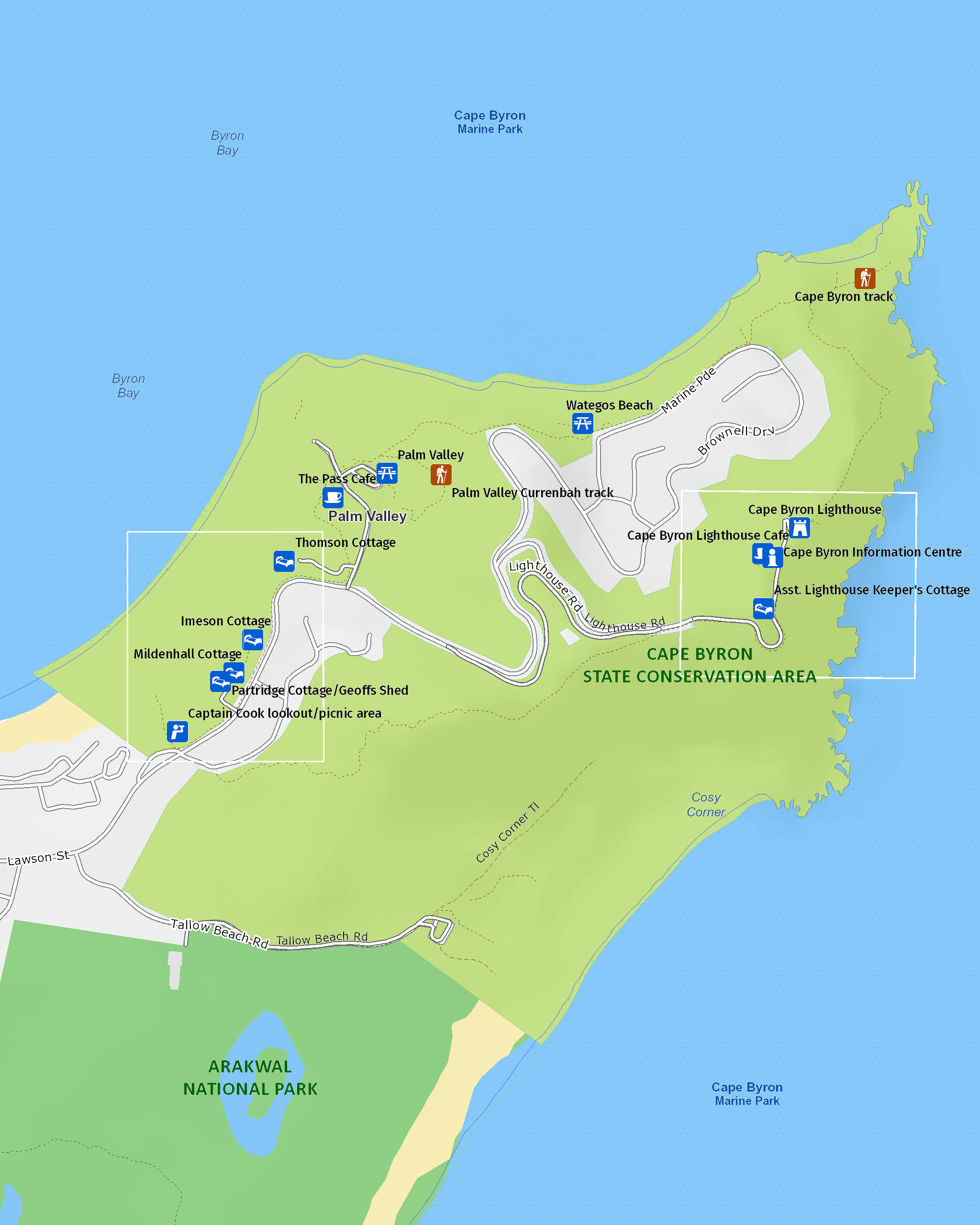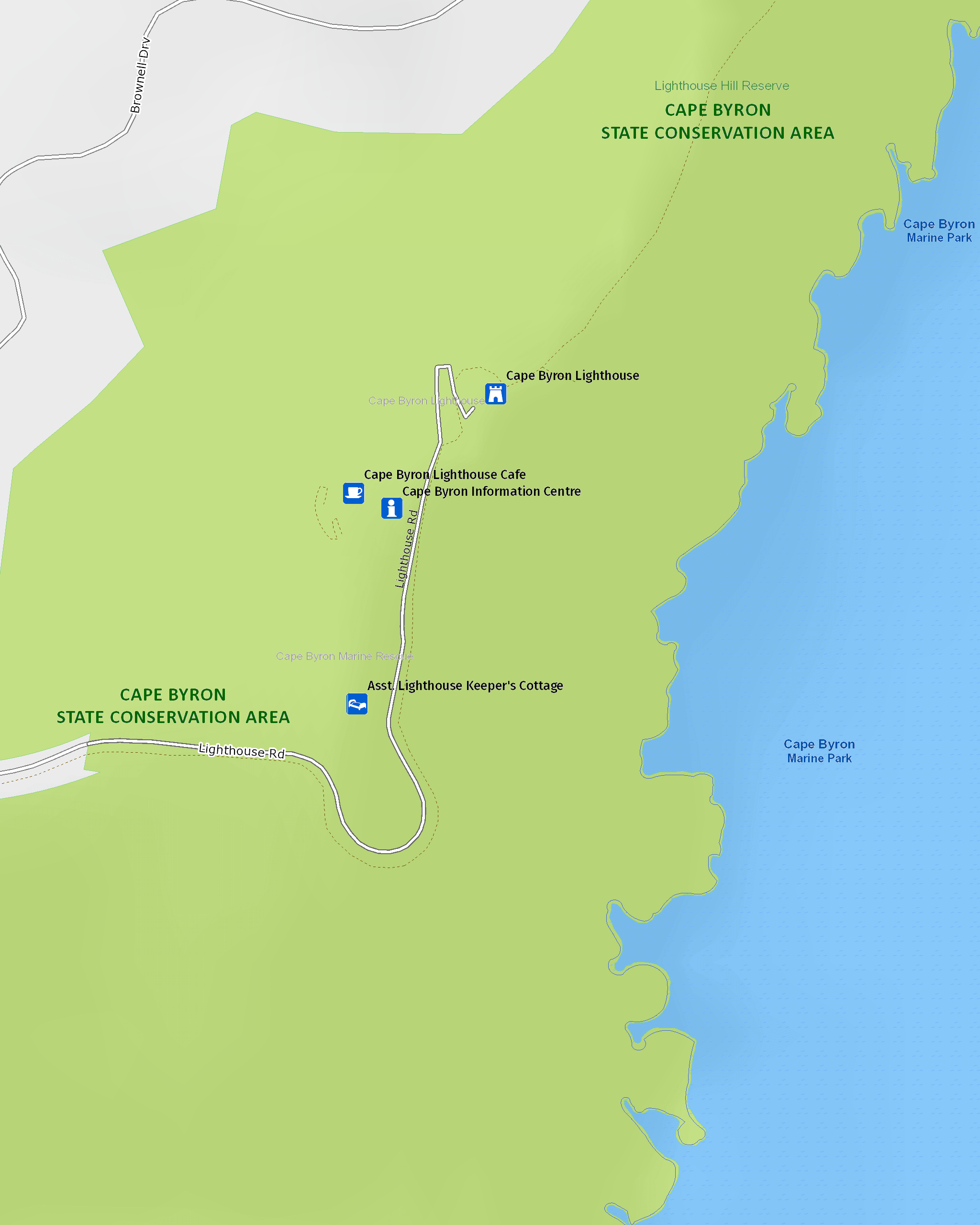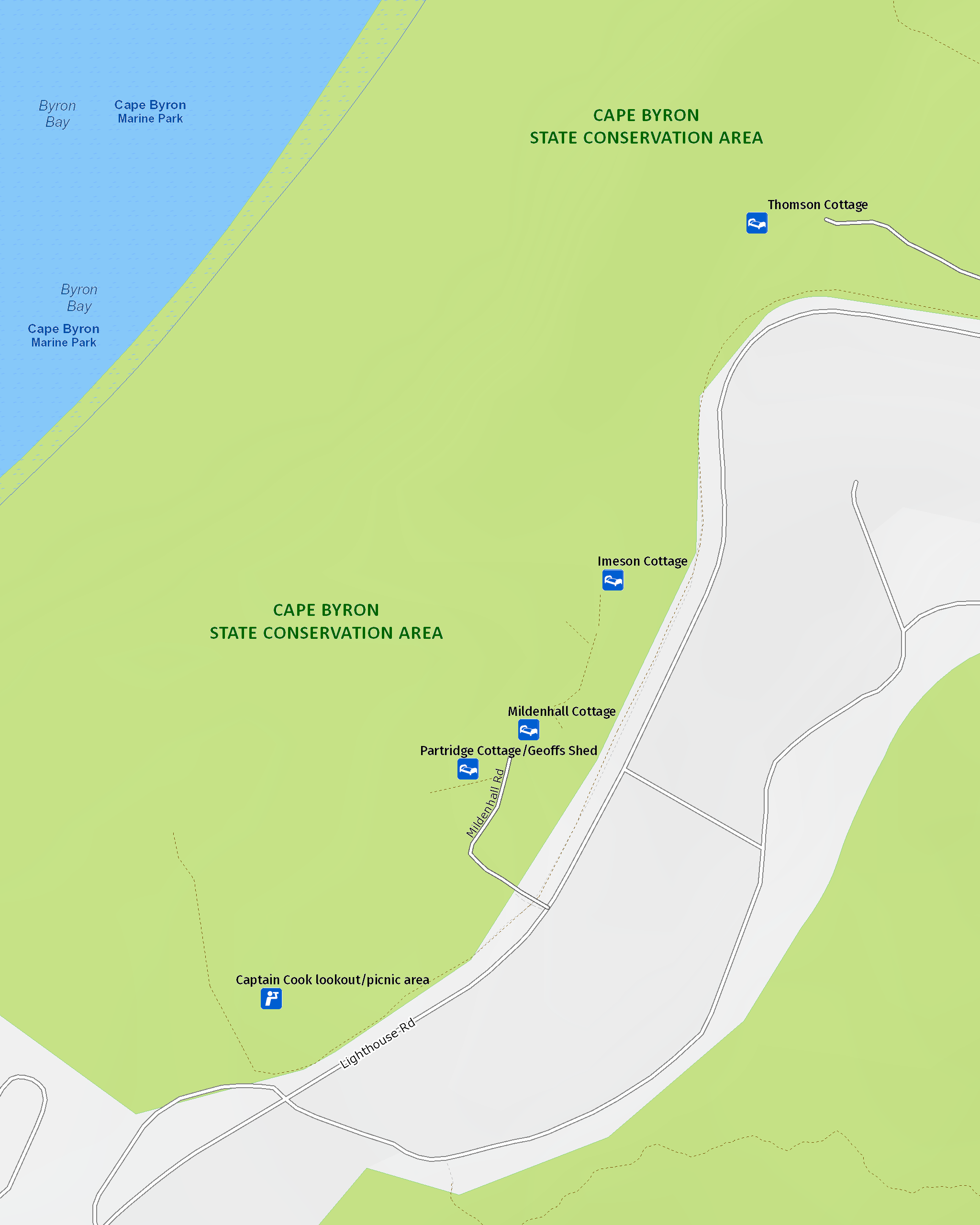Walgun Cape Byron State Conservation Area
Overview
Walgun Cape Byron State Conservation Area is great for school excursions and is home to Cape Byron lighthouse, heritage accommodation, walking tracks, scenic lookouts and the Cape Café.
Read more about Walgun Cape Byron State Conservation Area
For over a century, the elegant Cape Byron Lighthouse has graced Australia’s most easterly point. Its powerful lamp still burns brightly across the bay and you can visit this historic landmark or even stay in one of the charming keepers’ cottages. If you’d prefer to be closer to the beach, there’s a choice of award-winning eco-tourism beach cottages within the park.
Walgun Cape Byron is a brilliant location for whale watching and the walking track provides spine-tingling views of the surrounding coast and ocean. You can enjoy a bite to eat at the Cape Café, with panoramic views across the hinterland to Byron Bay.
Spend the afternoon relaxing on the beach – try The Pass, Wategos or Tallows. If you’re feeling more adventurous, there’s great diving, snorkelling, surfing, hang gliding and kayaking – go on your own or with licensed tour operators.
Local alerts
For the latest updates on fires, closures and other alerts in this area, see https://www.nationalparks.nsw.gov.au/visit-a-park/parks/walgun-cape-byron-state-conservation-area/local-alerts
Map

Map

Map

Map legend

Map

Map

Map

Contact
- in the North Coast region
- Walgun Cape Byron State Conservation Area is open all hours, but may have to close at times due to poor weather or fire danger.
- Cape Byron Lighthouse lawn is open 8am to sunset.
- The Maritime Museum in the former Lighthouse Keeper’s office at the base of the lighthouse is open 10am to 4pm daily.
- Opening before 8am for events or disabled access can be arranged by prior notice – contact NPWS Byron Bay office during business hours 02 6639 8300.
-
Park entry fees:
Cape Byron Lighthouse lawn and Information Centre: $10 per vehicle per hour/$4 per hour motorcycles. Maximum 1 hour per vehicle per calendar day, including all NPWS annual passholders.
Bawaii rest area, Cosy Corner, and The Pass: $5 per vehicle/motorcycle per hour. Tap and pay card or phone payments accepted at pay machines. Cash and credit cards accepted at Walgun Cape Byron Information Centre.
Coach entry: $30 per coach up to 30 seats; $57 per coach 31 to 43 seats; $94 per coach 44 seats and over.
Buy annual pass. -
-
Walgun Cape Byron Information Centre
02 6639 8300
Contact hours: 9.30am to 4.30pm daily. Closed Christmas Day - 199 Lighthouse Road, Byron Bay NSW 2481
-
Email: npws.tweedbyron@environment.nsw.gov.au
-
Walgun Cape Byron Information Centre
Visitor info
All the practical information you need to know about Walgun Cape Byron State Conservation Area.
Maps and downloads
Visitor centre
-
Walgun Cape Byron Information Centre
199 Lighthouse Road, Byron Bay NSW 2481 - 9.30am to 4.30pm daily. Closed Christmas Day
- 02 6639 8300
Nearby towns
Byron Bay (2 km)
Byron Bay is Australia's easternmost town and 'style capital' of the North Coast. It's a place of outstanding natural beauty, set against lush volcanic hills.
Bangalow (14 km)
Bangalow is a relaxed but stylish village close to Byron Bay. It's set in lush green hills near the coast.
Mullumbimby (20 km)
Mullumbimby sits on the Brunswick River and is overshadowed by subtropical hills.
Learn more
Walgun Cape Byron State Conservation Area is a special place. Here are just some of the reasons why:
View from the top

Walgun Cape Byron State Conservation Area is part of a significant north-to-south regional corridor for migratory animals, including the fruit dove and cuckoo shrike. Locals you might be lucky enough to spot while touring the area include threatened wallabies and sea eagles. A peaceful walk through the area’s serene littoral rainforest, with plant life; such as laurel trees, white lace flowers and basket ferns, to admire along the way, is sure to further enrich your experience of the Walgun Cape Byron area.
- A whale of a time Discover the wonderful world of whales on this Stage 2 (Years 3-4) excursion around Walgun Cape Byron headland. This excursion is designed to support the Living World Science and Technology topic content strand.
- Byron tandem hang gliding flights and lessons Try the thrilling sport of hang gliding with a tandem flight over spectacular Walgun Cape Byron or nearby Lennox Head. With 40 years’ experience, Byron Airwaves Hang Gliding School is your ticket to the freedom of flight.
- Walgun Cape Byron walking track Enjoy spectacular coastal views along the Walgun Cape Byron walking track that takes you on a hike through rainforest, beach, grassland and clifftops to the lighthouse.
- Walgun Cape Byron: The earth’s environment Join us on an Earth’s environment Geography excursion at beautiful Walgun Cape Byron for Stage 2 (Years 3-4) students. Students will explore the features of the reserve and learn about people’s differing perceptions of the park and how it is managed.
- Wategos Beach Located just north west of Walgun Cape Byron and the lighthouse, Wategos Beach is one of Byron’s best places to picnic, paddle and play.
Keepers of Country

Walgun, as Walgun Cape Byron is known by its traditional custodians, maintains spiritual, cultural and historical importance for the Bundjalung of Byron Bay (Arakwal) Aboriginal People. The pipi midden (shell mound) at The Pass is one of the largest and oldest in far north NSW.
- Dolphin Dreaming Dolphin Dreaming is an Early Stage 1 (Kindergarten) school excursion in Walgun Cape Byron State Conservation Area, focusing on Geography. Through story, dance and creative expression, Arakwal Aboriginal guides present the life and culture of Byron Bay's Aboriginal people.
- Dolphin Dreaming Dolphin Dreaming is a Stage 1 (Years 1-2) school excursion in Walgun Cape Byron State Conservation Area, focusing on Geography. Through story, dance and creative expression, Arakwal Aboriginal guides present the life and culture of Byron Bay's Aboriginal people.
- Dolphin Dreaming Dolphin Dreaming is a Stage 2 (Years 3-4) school excursion in Walgun Cape Byron State Conservation Area, focusing on Geography outcomes. Through story, dance and creative expression, Arakwal Aboriginal guides present the life and culture of Byron Bay's Aboriginal people.
- Dolphin Dreaming Dolphin Dreaming is a Stage 3 (Years 5-6) school excursion in Walgun Cape Byron State Conservation Area, focusing on Geography. Through story, dance and creative expression, Arakwal Aboriginal guides present the life and culture of Byron Bay's Aboriginal people.
- Palm Valley Palm Valley, or ‘The Pass,’ offers well-equipped picnic areas right by the beach, plus a popular café, several walking tracks, and access to the Fishermans lookout.
Cape Byron Lighthouse

Perched high above Byron Bay's glorious coastline, historic Cape Byron lighthouse was constructed on this rugged headland in 1901. Its landmark 22m high white tower houses the light that still illuminates the bay of an evening. To find out more about the lighthouse take a tour with an expert guide and be sure to check out the Maritime Museum. In days gone by, lighthouse keepers were responsible for igniting the lighthouse's light of an evening. The keepers have long been replaced by automated light systems; however the Victorian Georgian style cottages in which they lived remain as heritage listed buildings. Today they operate as holiday accommodation, having been carefully restored to offer modern convenience while retaining their historical charm and an insight into the life of a lighthouse keeper.
- Cape Byron Lighthouse private tour Step into the shoes of a lighthouse keeper on this private guided tour of the historical Cape Byron Lighthouse.
- Cape Byron Lighthouse: A special place Experience a bird’s eye view from the top of the iconic Cape Byron Lighthouse in this Early Stage 1 (Kindergarten) Geography excursion. Students will learn about the features of this special place and its significance to people and the community.
- Cape Byron Lighthouse: A special place Experience a bird’s eye view from the top of the iconic Cape Byron Lighthouse in this Stage 1 (Years 1-2) geography excursion. Students will learn about the features of the lighthouse and its significance to people and the community.
- Walgun Cape Byron Information Centre Walgun Cape Byron Information Centre is the place to find visitor information for Walgun Cape Byron State Conservation Area, Walgun Cape Byron Marine Park and surrounding national parks in the Byron Bay area.
Plants and animals protected in this park
Animals
-

Australian pelican (Pelecanus conspicillatus)
The curious pelican is Australia’s largest flying bird and has the longest bill of any bird in the world. These Australian birds are found throughout Australian waterways and the pelican uses its throat pouch to trawl for fish. Pelicans breed all year round, congregating in large colonies on secluded beaches and islands.
-

Australian brush turkey (Alectura lathami)
The Australian brush turkey, also known as bush or scrub turkey, can be found in rainforests along eastern NSW. With a striking red head, blue-black plumage and booming call, these distinctive Australian birds are easy to spot while bird watching in several NSW national parks.
-

Superb fairy wren (Malurus cyaneus)
The striking blue and black plumage of the adult male superb fairy wren makes for colourful bird watching across south-eastern Australia. The sociable superb fairy wrens, or blue wrens, are Australian birds living in groups consisting of a dominant male, mouse-brown female ‘jenny wrens’ and several tawny-brown juveniles.
Plants
-

Wonga wonga vine (Pandorea pandorana)
The wonga wonga vine is a widespread vigorous climber usually found along eastern Australia. A variation of the plant occurs in the central desert, where it resembles a sprawling shrub. One of the more common Australian native plants, the wonga wonga vine produces bell-shaped white or yellow flowers in the spring, followed by a large oblong-shaped seed pod.
-

Cabbage palm (Livistona australis)
With glossy green leaves spanning 3-4m in length and a trunk reaching a height of up to 30m, the cabbage tree palm, or fan palm, is one of the tallest Australian native plants. Thriving in rainforest margins along the east coast of NSW, in summer this giant palm produces striking spikes of cream flowers which resemble cabbages.
Environments in this park
Education resources (1)
School excursions (11)
- A whale of a time, Stage 2 (Years 3-4), Science and Technology
- Dolphin Dreaming, Early Stage 1 (Kindergarten), Geography
- Dolphin Dreaming, Stage 1 (Years 1-2), Geography
- Walgun Cape Byron: Environmental change and management, Stage 5 (Years 9-10), Geography
- Walgun Cape Byron: The earth’s environment, Stage 2 (Years 3-4), Geography
- Cape Byron Lighthouse: A special place, Early Stage 1 (Kindergarten), Geography
- Dolphin Dreaming, Stage 2 (Years 3-4), Geography
- Dolphin Dreaming, Stage 3 (Years 5-6), Geography
- Whale secrets, Stage 1 (Years 1-2), Science and Technology
- Whale secrets, Early Stage 1 (Kindergarten), Science and Technology
- Cape Byron Lighthouse: A special place, Stage 1 (Years 1-2), Geography
What we're doing
Walgun Cape Byron State Conservation Area has management strategies in place to protect and conserve the values of this park. View the detailed park and fire management documents. Here is just some of the work we’re doing to conserve these values:
Understanding landscapes and geology
Walgun Cape Byron State Conservation Area maintains and preserves the land and scenery within its borders. Visitors are able to fully enjoy its attractions as facilities and surrounding landscapes are regularly and carefully maintained.
Managing weeds, pest animals and other threats
Pests and weeds have a significant impact to the ecosystems within Walgun Cape Byron State Conservation Area. Risk assessments for new and emerging weeds are carried out as an ongoing initiative within the park. Pest management of bitou bush is an important part of the work NPWS does to protect the integrity of biodiversity which exists within Cape Byron.
Developing visitor facilities and experiences
Walgun Cape Byron State Conservation Area is committed to developing visitor facilities for its customers’ enjoyment and safety. Regular maintenance, upgrading and installation of recreational, accommodation and retail amenities and infrastructure take place in this park. NPWS works to monitor vulnerable species and address threats, which can include feral animals and weeds, and implements actions to target their impacts.
Conserving our Aboriginal culture
There are a number of significant Aboriginal sites and artefacts within Cape Byron Conservation Area. NPWS is committed to protecting these important cultural items, and interpretive and educational programs are ongoing in this park.
Managing fire
NSW is one of the most bushfire prone areas in the world as a result of our climate, weather systems, vegetation and the rugged terrain. NPWS is committed to maintaining natural and cultural heritage values and minimising the likelihood and impact of bushfires via a strategic program of fire research, fire planning, hazard reduction, highly trained rapid response firefighting crews and community alerts.

